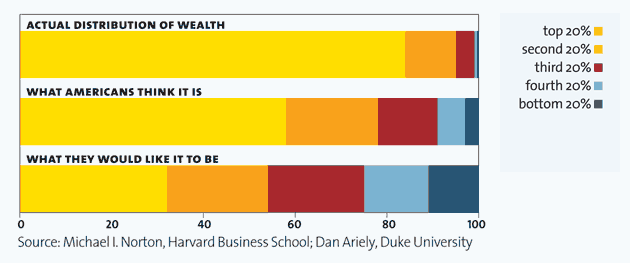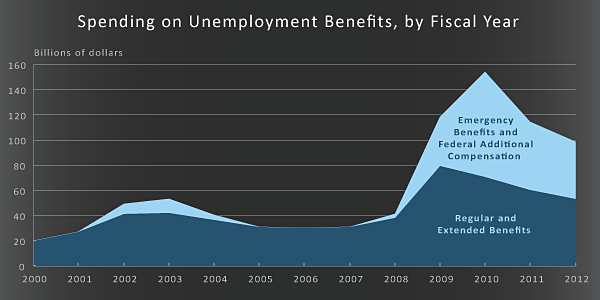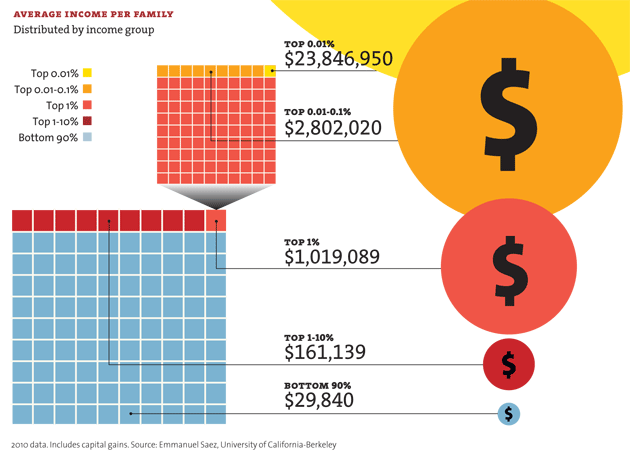Here is a video that explains income inequality–by Robert Reich.
Click Here
Category Archives: Economy
Taxing the Rich?
This from Paul Krugman’s blog: Taxing the Rich post
He writes: “First, over the past three decades we’ve seen a soaring share of income going to the very top of the income distribution (right scale) even as tax rates on high incomes have fallen sharply, with the recent Obama increases clawing back only a fraction of the previous cuts.”

The essential question is simply this: what income distribution is best for America as a whole? Does inequality hurt the economy, and if so, how much income inequality can be tolerated before it harms the economy? Given that we have a consumer-based economy, if people are limited in the amount of consumption because they have limited resources, at what point does the economy stall? At what point does it make an economic recovery fail?
The same question can be posed about taxes. What is the best tax structure for America as a whole? There is no question in my mind that the Bush-era tax cuts were a huge failure from the perspective of both the federal deficit and the debt. We quickly went from a budget surplus to a budget deficit, that got worse as the economy continued to weaken. Other factors played a role, but when the budget started to cross into the red, and especially with the costs associated with two wars, the tax cuts should have been canceled. Continue reading
Looking at the Headlines
Our Current Economic Mess, Explained With Headlines
I was doing research, gathering headlines for a post. But the headlines told a story of their own. So here they are: 2010 November 2010, Corporate Profits Hit New Record, U.S. Workers Still Struggling 2011 January 2011, Profits Are Booming. Why Aren’t Jobs? May 2011, Corporate Profits At All-Time High As Recovery Stumbles June 2011, Since 2009, 88 Percent Of Income Growth Went To Corporate Profits, Just One Percent Went To Wages July 2011, Corporate profits’ share of pie most in 60 years July 2011, A Boom in Corporate Profits, a Bust in Jobs, Wages August 2011, Companies near record profits amid high unemployment October 2011, While Corporate Profits Are At 60-Year High, Main Street Businesses Continue To Struggle November 2011, GDP revised downward; corporate profits up 2012 February 2012, Corporate Margins And Profits Are Increasing, But Workers’ Wages Aren’t May 2012, Corporate Profits Return To Prerecession Levels, But Job Growth And Investment Remain Weak June 2012, Corporate Profits Just Hit An All-Time High, Wages Just Hit An All-Time Low July 2012, The Economy Stinks, but at Least Corporate Profits Are at 60-Year Highs! December 2012, Corporate profits hit all-time high as wages drop to record low 2013 March 4, 2013, Corporate Profits Have Risen Almost 20 Times Faster Than Workers’ Incomes Since 2008
2010 November 2010, Corporate Profits Hit New Record, U.S. Workers Still Struggling 2011 January 2011, Profits Are Booming. Why Aren’t Jobs? May 2011, Corporate Profits At All-Time High As Recovery Stumbles June 2011, Since 2009, 88 Percent Of Income Growth Went To Corporate Profits, Just One Percent Went To Wages July 2011, Corporate profits’ share of pie most in 60 years July 2011, A Boom in Corporate Profits, a Bust in Jobs, Wages August 2011, Companies near record profits amid high unemployment October 2011, While Corporate Profits Are At 60-Year High, Main Street Businesses Continue To Struggle November 2011, GDP revised downward; corporate profits up 2012 February 2012, Corporate Margins And Profits Are Increasing, But Workers’ Wages Aren’t May 2012, Corporate Profits Return To Prerecession Levels, But Job Growth And Investment Remain Weak June 2012, Corporate Profits Just Hit An All-Time High, Wages Just Hit An All-Time Low July 2012, The Economy Stinks, but at Least Corporate Profits Are at 60-Year Highs! December 2012, Corporate profits hit all-time high as wages drop to record low 2013 March 4, 2013, Corporate Profits Have Risen Almost 20 Times Faster Than Workers’ Incomes Since 2008
Wealth Inequality
This video came across my computer screen today. It is taking graphic representation to a new level.
Check it out: Video by Evan Klassen
Of course, it helps to know what he defines as “wealth.” It means tracking down the Harvard study as a starting point. Still, as an example of the use of graphics, it does a good job of presenting a complex set of data.More data can be found at Mother Jones: It’s the Inequality, Stupid. Mother Jones puts it all in charts.
This is the chart that the video leads with–comparing the different in perceptions and reality about wealth distribution.
Middle Class Revisited
 The Wall Street Journal has an article trying to define the middle class.
The Wall Street Journal has an article trying to define the middle class.
Check it out Here
It is a lot more complicated than it appears. The median household income varies by states and even by counties within states. Using the middle 60% of income provides a ridiculously wide group of households.
Tracking Government Subsidies to Businesses
The New York Times published the results of 10 months of research looking at state, local and county taxpayer money that goes to businesses.
Interesting way to display day.
Government Subsidies to Businesses
“The Times identified 48 companies that have received more than $100 million in state grants since 2007. Some 5,000 other companies have received more than $1 million in recent years.”
Read the article here: Companies Seek Tax Deal
Read the methodology: Continue reading
CBO: Unemployment Insurance
CBO released a report today about Unemployment Insurance. “The unemployment insurance (UI) system is generic cialis online a partnership between the federal government and state governments that cialisonline-storeedtop provides a temporary weekly benefit to qualified workers who lose their job and are seeking work. overnight viagra The amount of that benefit is based in part on a worker’s past earnings. CBO estimates that UI benefits totaled $94 billion in fiscal year 2012 (when viagra en video the unemployment rate was 8.3 legal canadian pharmacy online percent, on average), a substantial increase over cialis online the $33 billion paid out in fiscal year 2007 (when the unemployment rate was 4.5 percent, on average).”  See Report Here
See Report Here
The Debt Merry-go-Round: cool chart
The Economist has a very cool interactive chart that looks at world debt as a percentage of GDP. Yes, it is possible to have more debt than the Gross Domestic Product.
Compare the countries:
World Debt: The Economist
September 2012.
Congressional Research Service: Taxes and the Economy Report
A new Report from the Congressional Research Services looks at tax policy and pfizer viagra price the economy raises questions about the relationship between taxes, savings, economic productivity, and income inequality. It states: “Throughout the late-1940s and 1950s, the top marginal tax rate was typically above 90%; today it is 35%. Additionally, the top capital gains tax rate was 25% in the 1950s and 1960s, 35% in the 1970s; today it is 15%. The real GDP growth rate averaged 4.2% and real per capita GDP increased annually by 2.4% in the 1950s. In the 2000s, the average real GDP growth rate was 1.7% and real per capita GDP increased annually by less than 1%. There is not conclusive online canadian pharmacy evidence, however, canadian online pharmacy viagra to substantiate a clear relationship between the 65-year steady reduction in the top cialis in 20s tax rates and economic growth. Analysis of such data suggests the reduction in the top tax rates have had little association with saving, investment, or productivity growth. However, the top tax rate reductions appear to be associated with the increasing concentration of income at the top of the income distribution. The share of income accruing to the top 0.1% of U.S. families increased from 4.2% in 1945 to 12.3% by 2007 before falling to 9.2% due to the 2007-2009 recession. The evidence does not suggest necessarily a relationship between tax policy with regard to the top tax rates and the size of the economic pie, but there may be a relationship to how the economic pie is sliced.” Full report:CRS: Taxes and the Economy No doubt, this will viagraonline-edstore.com generate a swirl of reaction. Stay tuned.
How Much Money Defines Middle-Class?
The story making the circuit today about Presidential candidate Mitt Romney is this: “According to his response to a question about whether or not he considers “middle class” income for Americans to be somewhere around “$100,000” by ABC’s George Stephanopoulos on Friday, Romney rejected that number. “No,” Romney said. “Middle income is $200,000 to $250,000 and less.” Really? According to the latest report from the Census Bureau, 4% of all households in American earned more than $200,000 in 2011. Or put another way, 96% of American households earned less than $200,000. Does not sound like the middle to me. Census Report: Click Here What might be a better measure? In Table A-1, Households by Total Money Income, the Census reports that: the median household income (that is, the income where 50% of the population is above and 50% is below) is $50,054. This is less than the high of $54,546 in 2007; since the economic crash, median income has been on a downward slide since 2007 and has not bottomed yet. Of course, we could look at the mean (average) household income. That is higher at $69,677, but still shows a decline from a peak in 2006 of $74,259. Generally, when dealing with income, the median income is a better description of where the middle is; averages can be distorted by very high earnings. Still–$54,00 or $69,000 is a long way from $200,000. Continue reading
